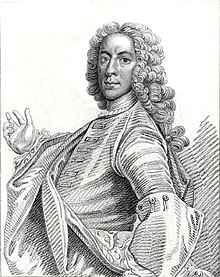John Taylor | |
|---|---|
 | |
| Born |
c. 1703 |
| Died | 1770 or 1772 |
| Occupation(s) | Surgeon, charlatan |
| Relatives | John Taylor (grandson) |

Chevalier John Taylor ( c. 1703 – 1770 or 1772) was an early British eye surgeon, self-promoter and medical charlatan of 18th-century Europe. He was noted by Samuel Johnson, and associated with the surgical mistreatment of George Frideric Handel, Johann Sebastian Bach, and perhaps hundreds of others. [1]
Career
Taylor was born in Norwich, possibly in 1703. [2] He was the son of a surgeon named John Taylor, who died in 1709. [2] He studied in London under the pioneering British surgeon William Cheselden at St Thomas' Hospital, [2] and by 1727 had produced a book, An Account of the Mechanism of the Eye, dedicated to Cheselden. [3]
While his practice grew, operating on celebrities of the time such as Edward Gibbon, making the acquaintance of Viennese courtier and patron of composers Gottfried van Swieten, and being appointed royal eye surgeon to King George II, his flair for self-promotion grew with it, then beyond it. He dubbed himself "Chevalier", though the source of his title (equivalent to "knight" in English) is questionable, and his claims to be from an aristocratic family were false. He was not ennobled until 1755, by Pope Benedict XIV. [2] Taylor toured Europe in a coach painted with images of eyes, performing the ancient technique of couching cataracts and other techniques in something like an eye surgery travelling medicine show, with claims, treatments, and payments coordinated for an easy exit out of town. [4] In his expansive 1761 autobiography in two volumes, The Life and Extraordinary History of the Chevalier John Taylor, Taylor styled himself "Ophthalmiater (sic) Pontifical, Imperial, Royal."
Taylor's career was destructive. His general approach included bloodletting, laxatives, and eyedrops of blood from slaughtered pigeons, pulverized sugar, or baked salt. Some time in late March 1750, during one of his European tours, Taylor operated on Bach's cataracts twice in Leipzig and reportedly blinded him. Bach fell ill with a fever soon after his second operation and died less than four months later. There is some evidence that Taylor operated on Handel in August 1758, in Tunbridge Wells, after which Handel's health deteriorated until his death in April 1759. In both cases Taylor claimed complete success. [3] Prior to performing each surgical procedure, he would deliver a long, self-promoting speech in an unusual oratorial style. [5] Dutch ophthalmologist R. Zegers mentions that "after his training, Taylor started practicing in Switzerland, where he blinded hundreds of patients, he once confessed". [6] Writer Samuel Johnson said of Taylor that his life showed "an instance of how far impudence may carry ignorance."
The time and place of Taylor's death are uncertain. [2] The musicologist Charles Burney claimed that he died on the morning of Friday 16 November 1770 in Rome, also claiming to have "dined with him at my table d'hote a few days before his death". [7] He was also said to have died in Paris. [8] In June and July 1772, several newspapers in Germany [9] and England reported that he had recently died at a convent in Prague, completely blind, after having suffered from amaurosis; [2] this version was also supported by Taylor's grandson John Taylor. [10] [2]
See also
References
- ^ Smith, Susan Lambert (14 December 2009). "Handel, Bach Were Blinded by '18th Century Quackery'". University of Wisconsin Madison School of Medicine and Public Health. Archived from the original on 27 July 2017.
- ^ a b c d e f g Stephen G. Schwartz; Christopher T. Leffler; Andrzej Grzybowski; Hans-Reinhard Koch; Dennis Bermudez (January 2015). "The Taylor Dynasty: Three Generations of 18th-19th Century Oculists" (PDF). Hist Ophthal Intern. 1 (1): 67–81.
- ^ a b Jackson, David M. (October 1968). "Bach, Handel, and the Chevalier Taylor" (PDF). Medical History. 12 (4): 385–393. doi: 10.1017/s002572730001365x. PMC 1033864. PMID 4884222. S2CID 43613730. Archived (PDF) from the original on 20 October 2017.
- ^ Hirschberg, Julius (1986). The history of ophthalmology, Volumen 11, Parte 2. Wayenborgh. ISBN 9780897223232. Retrieved 13 January 2015.
- ^ Barrell, John (1 April 2004). "The Reptile Oculist". London Review of Books. 26 (7): 19–25. Archived from the original on 26 March 2019.
- ^ Zegers, Richard H. C. (2005). "The Eyes of Johann Sebastian Bach". Archives of Ophthalmology. 123 (10): 1427–1430. doi: 10.1001/archopht.123.10.1427. PMID 16219736.
- ^ Burney, Charles (1969). Poole, H. Edmund (ed.). Music, Men, and Manners in France and Italy, 1770. London: The Folio Society. p. 206.
- ^ R. Rutson James (1933). Studies in the History of Ophthalmology in England prior to the Year 1800. Cambridge: The University Press, Pub. for the British journal of ophthalmology.
- ^ Wöchentliche Nachrichten von gelehrten Sachen auf das Jahr 1772 (in German). Regensburg: Keyser. 1772. p. 216.
- ^ Taylor, John (1832). Records of My Life: In Two Volumes, Volumen 1. Bull. p. 24. Archived from the original on 13 January 2015.
Further reading
- Albert, Daniel M.; Henkind, Paul (1993). "John Taylor: 1703–1772". Men of Vision: Lives of Notable Figures in Ophthalmology. Philadelphia: Saunders. pp. 41–49. ISBN 0-7216-4512-7.
- Albert, Daniel M. (2011). Chevalier John Taylor: England's Early Oculist: Pretender or Pioneer?. Madison, WI: Parallel Press. ISBN 978-1-934795-32-3.
- Wright, A. Dickson (1957). "Quacks Through the Ages". Journal of the Royal Society of Arts. 105 (4995): 161–178. JSTOR 41368549.
- Carlyle, E. Irving (1898). "Taylor, John (1703–1772)". In Lee, Sidney (ed.). Dictionary of National Biography. Vol. 55. London: Smith, Elder, & Co. pp. 441–442.